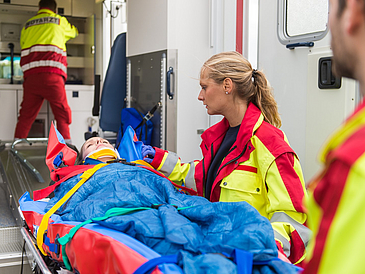The ambulance is racing down the highway at 150 km/h. Doctors are caring for an accident victim who has to be operated as soon as he or she arrives at the hospital. Important examinations are already carried out in the ambulance, the injured person is X-rayed, and basic patient data is transmitted directly to the operating theater. Using a video link, the paramedics and the doctors in the operating theater can talk to each other – and even an up-to-date X-ray image can be provided from the ambulance for diagnosis. Even before the patient arrives, the surgeons can get an idea of the situation and prepare the necessary medical technology in the operating theater.
Efficient data and information exchange as the goal
That is all still a dream of the future. “At the moment, communication between the ambulance and the emergency center is usually limited to telephone calls – if the time pressure and circumstances of the emergency allows this at all”, says Professor Armin Dekorsy, head of the Department of Communications Engineering of the Faculty of Physics/Electrical Engineering at the University of Bremen. But the dream might become reality soon, because as part of the Mobile Medical Technology for Integrated Emergency Care and Accident Medicine collaborative project, funded with 6.6 million euros by the Federal Ministry of Education and Research (BMBF), an efficient data and information exchange from the scene of the accident to the hospital is now to be developed and tested.
“Among the 14 participating institutions, we are the only partner in the project dealing with 5G communication and the cross-linking of devices in the ambulance”, says Dr. Carsten Bockelmann of the Department of Communications Engineering who works together with five researchers as part of the MOMENTUM project in Bremen on optimizing the use of new radio technologies. For this the working group received 1.4 million euros of project funding. “The other partners are primarily concerned with medical technology and medical applications as well as legal and ethical questions.”
Emergency responders often cut off from the information flow
So far, emergency responders are largely cut off from the information flow when they care for patients at the emergency scene. Assistance can often only be provided by telephone via the emergency call center, but due to time constraints, this is rarely taken up. On the other hand, before the ambulance arrives, various specialists prepare the emergency room in advance. However, they often only have little information about the arriving victim. At the same time, an operating theater is immediately reserved and kept available until the end of the examination, which might well last several hours. However, it is not possible to prepare for a specific emergency intervention: “There is hardly any information available on the injuries, the current clinical condition of the accident victim, or the measures already taken,” says Professor Dekorsy. “But these are extremely important for ensuring the best possible treatment. At the moment, there are still no systems that can satisfactorily support these complex processes of emergency intervention.”
The MOMENTUM project aims now to develop and test suitable concepts and technologies for networking. In order to translate the networking technologies into medical technology applications, current framework conditions are examined from a technical, ethical, legal, and social point of view. These will then form the basis for the practice-oriented transfer of patient data, process information, video and audio data.
Maintaining a stable connection
“In order to reliably transmit data, ambulances, for example, become mobile radio cells. These can then be used to connect medical devices to the wired core network of the mobile phone network”, says Carsten Bockelmann. To ensure that the connection to this core network remains stable, an additional connection via drones is to be established. They forward the signal in order to increase the range of the mobile cell on the one hand. However, this can also help to overcome transmission gaps – for example in rural areas.
This opens up the possibility of carrying out diagnoses and therapies over great distances using the communication technologies developed in the project. In order to integrate medical devices as flexible as possible, an intermediate level is being developed in the project, which will create an interface to the mobile phone network independent of mobile network operators. In order to ensure a high practical relevance, model cases will be used to evaluate the results.
Acclaimed expertise in new mobile communications standards
The results of the MOMENTUM project are to set new standards in emergency response. “The wireless technologies developed by us in the project allow the bundled transmission of all relevant information from the scene of the accident to the hospital,” says Armin Dekorsy. “This enables a new type of coverage between the ambulance and the trauma center in the hospital, and the comprehensive remote monitoring of emergency patients by means of communication technology is made possible from the very moment the first aid is initiated.” The Department of Communications Engineering of the University of Bremen has built up considerable and widely recognized expertise over the past few years with regard to the functionality of modern mobile communications standards and their potential applications.
Coordinator of the MOMENTUM research network is the University of Leipzig (Innovation Center Computer Assisted Surgery / ICCAS). Alongside the Department of Communications Engineering of the University of Bremen, there are twelve other partners: the University of Lübeck, University Hospitals of Leipzig and Schleswig-Holstein, the Heinrich-Braun-Clinic (HBK), the SurgiTaix AG, the ERNW Research GmbH, the Primedic GmbH, the Weinmann Emergency Medical Technology GmbH & Co.KG, the Draeger AG & Co KGaA, thee Karl Storz GmbH & Co KG, the Notarztdienste.de GmbH as well as the Johanniter-Unfall-Hilfe e.V.
Further Information:
www.ant.uni-bremen.de/en/home/ www.forschung-it-sicherheit-kommunikationssysteme.de/projekte/momentum (in German)
www.uni-bremen.de/en/
Contact:
Prof. Dr.-Ing. Armin Dekorsy
University of Bremen
Phone: +49 421 218-62400
Email: dekorsyprotect me ?!ant.uni-bremenprotect me ?!.de
Dr.-Ing. Carsten Bockelmann
Phone: +49 421 218-62386
Email: bockelmann@ant.uni-bremen.de
Both are members of the Department of Communications Engineering,
Faculty of Physics/Electrical Engineering, University of Bremen

